Millennials in the City of Toronto and CMA Are Heading to the Rest of the Greater Golden Horseshoe, but Are Being Replaced by Immigration
By: Diana Petramala
(PDF file) Print-Friendly Version Available
October 30, 2019
Both the Financial Times and the Washington Post reported recently that the populations of several major cities in developed countries – from Paris to New York – are falling as Millennials start heading to the suburbs in search of bigger and more affordable housing. Even in cities where immigration is boosting population, more of the non-immigrant population were leaving them than were being attracted to them.
We were curious about how this “stated” trend played out for the city of Toronto and the Toronto Census Metropolitan Area (CMA). Overall, at the time of Statistics Canada’s last population estimate of July 1st, 2018, the city of Toronto appears to have bucked this global trend.
How a metropolitan region and its major cities grow
Outside of births and deaths, a city’s population can grow/shrink in three ways:
- Net intraprovincial migration - net intraprovincial migration is the number of persons from other parts of the province moving to the city less the number of people from the city moving to other parts of the province;
- Net interprovincial migration - net interprovincial migration is the number of persons from other provinces moving to the city less the number of people from the city moving to other provinces; and/or
- Net immigration - net immigration is the number of persons moving to the city from other countries less the number of people from the city moving to other countries - on a permanent or temporary (e.g. students, refugees or anyone coming to Canada through the new Global Talent Program) basis.
Both the city of Toronto and the CMA lost population to other parts of the province according to the 2018 estimates, but growth from net immigration swamped this net domestic outflow
The latest population estimates from Statistics Canada show that, much like the case in other major global cities, between July 1st 2017 and July 1st 2018 more non-immigrant persons left the city of Toronto and the Toronto CMA for other cities in Ontario than moved to the region from within the province (see Figure 1).
However, population growth in the city and the CMA from sources outside the province swamped the outflow from net intraprovincial migration. The combination of net immigration and net interprovincial migration attracted three times as many people as were leaving for the suburbs in both the city of Toronto and the CMA.
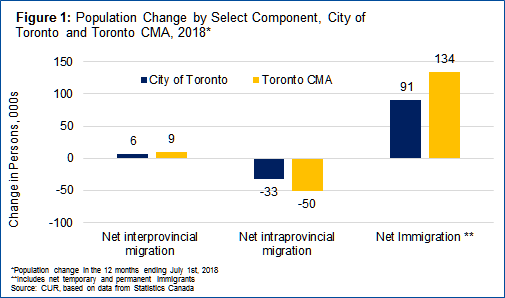
Population boomed among those aged 15 to 44 years in the 12 months ending July 1st 2018
While the definition of Millennials always seems to be changing, most definitions include those who are currently 25 to 34 years of age. Population growth among this age group is still going strong in the city of Toronto and the CMA as a whole. However, the fastest growing age segment of the population in 2018 was for those 15 to 24. In contrast, growth for the age bracket for those 45 years and older is in decline, although it represents a relatively small flow of people.
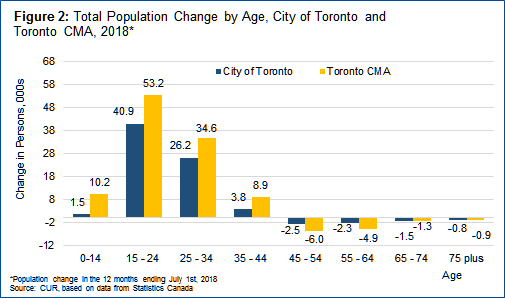
Intraprovincial migration was negative in all age brackets, except for those aged 15 to 24
Similar to the case in other major cities, the trend among the non-immigrant population for most age brackets in the 2018 estimates was a net outflow from the city of Toronto and the CMA to other parts of Ontario (see Figure 3). This trend of intraprovincial migration was seen among Millennials, Generation X and Boomers. However, those under 25 continued to be attracted to the city of Toronto.
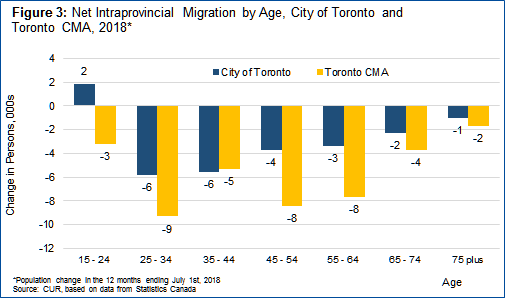
Economic softness outside of Ontario attracted more persons between the ages of 15 to 44 to the province
The drop in oil prices in 2014 negatively impacted the economy in Canada's oil producing regions, encouraging larger numbers of persons to move to Ontario in search of jobs.
Interprovincial migration into the city of Toronto and the CMA in 2018 hit its fastest pace in over a decade. This trend was most significant among Millennials (25 to 34) and Generation Xers (35 to 54) (see Figure 4).
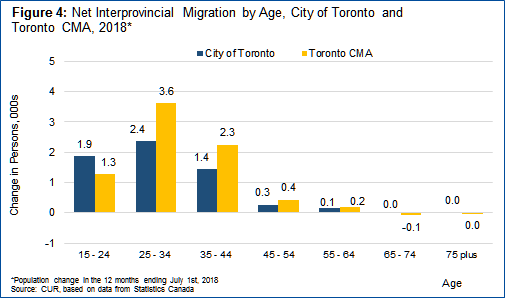
Net immigration swamped net interprovincial and intraprovincial migration for those 15 to 44
Unlike many other major cities, the city of Toronto and the CMA benefited largely from net immigration (see Figures 5 and 6). Net immigration was by far the largest component of population growth for the 15-44 age segment in 2018. The city saw growth in the younger age brackets especially, attracting more than three times as many Millennials and adult Generation Zers than Generation Xers.
However, this trend varied based on the type of immigration. Millennials represented the leading source of permanent immigration to the Toronto Region, and most of them settled in the city of Toronto (see Figure 5). Meanwhile, growth from net temporary immigration was boosted by an influx of those aged 15 to 24. Net temporary immigration was negative for anyone older than 25, meaning that more people within this age group either choose to come to the city on a temporary basis or choose to return to their place of origin as opposed to remaining (see Figure 6).
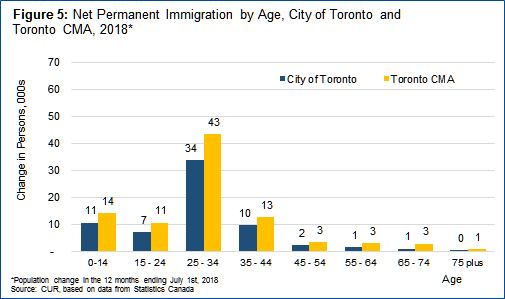
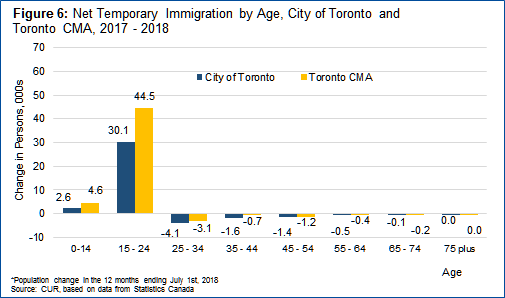
The city of Toronto and the Toronto CMA appear to be bucking the global trend of losing Millennials to the outskirts of the urban regions. This is largely due to the continuing immigration to the region on the part of this age bracket. This strength in Millennial immigration, combined with an increase in temporary immigration among the younger generations, is what has earned the city of Toronto its title as the fastest growing city in North America and the Toronto CMA the second fastest growing metropolitan area.1
However, a larger number of non-immigrant Millennials and Generation Xers already living in the region seem more likely to leave for other parts of the Greater Golden Horseshoe.
_________________________________________________________________________________________________________
Sources:
[1] Frank Clayton and Hong Yun (Eva) Shi (2019). “WOW! Toronto Was the Second Fastest Growing Metropolitan Area and the Top Growing City in All of the United States and Canada”. [Online] Available https://www.torontomu.ca/cur/Blog/blogentry35/
Diana Petramala is Senior Researcher at Toronto Metropolitan University's Centre for Urban Research and Land Development (CUR) in Toronto.